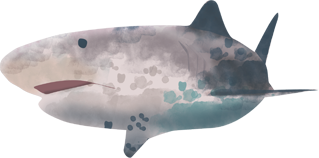introduction
Mangroves, seagrass meadow and coral reefs: complementary ecosystems of great richness that play an active role in coastal preservation!

Mangrove
Mangroves are a very effective ecosystem to fight climate change effects and pollution linked with human activities. They developing on coastline, between land and sea, and protect the coast in the event of a heavy storm.
Due to growing up in brackish water (between freshwater and salt water), mangrove’s trees developed the filtration capacity of salt in water.


130
different species of fish
are juveniles
(essential nursery role).
Mangrove’s trees :
Two flagship actions of Cáyoli for mangroves : creation of nursery of mangrove’s trees to restore the guadeloupean mangroves and the layout of ecotourism sites for their knowledge and preservation.
Coastal shallows
The discrete seagrass meadows have an essential role during strong swell episodes: they retain sediments and mechanically restrain the currents.
Achieving the photosynthesis to feed themselves, they actively participate in the storage of CO2.
In Guadeloupe, they are essential for three emblematic species: the renowned pink conch, the White Sea urchin and the green turtle.


Pink Conch
It is a protected species by several international texts. In Guadeloupe they can only be fished by professionals, from 1st October to 31 January. To be capture they must reach a minimum weight of 250g of cleaned flesh.
Thanks to Cáyoli, a seagrass meadows nursery has been created to restore damage areas.
120
fish species.
of the seagrass meadows are in good health
Coral reefs
The coral reefs are comparable to the Amazon rainforest: few species feed directly on them, but they constitute an essential ecosystem for an abundant biodiversity! Corals have an essential role in the protection of the coastline: in the event of a storm they reduce the energy of the waves. Thus, they protect the coast and the ecosystems in between, but also the human activities implanted on the seaside.


Corals, fragile animals to protect
Corals are very fragile because they are sensitive to variations in their environment. Corals are very fragile because they are sensitive to variations in their environment. Their sale and collection are prohibited “at any time and in any place” by several international regulations. A breeding and growth nursery has been set up with Cáyoli. The corals will be used to restore degraded reefs.
80%
of marine species
0.1%
of the maritime surface

